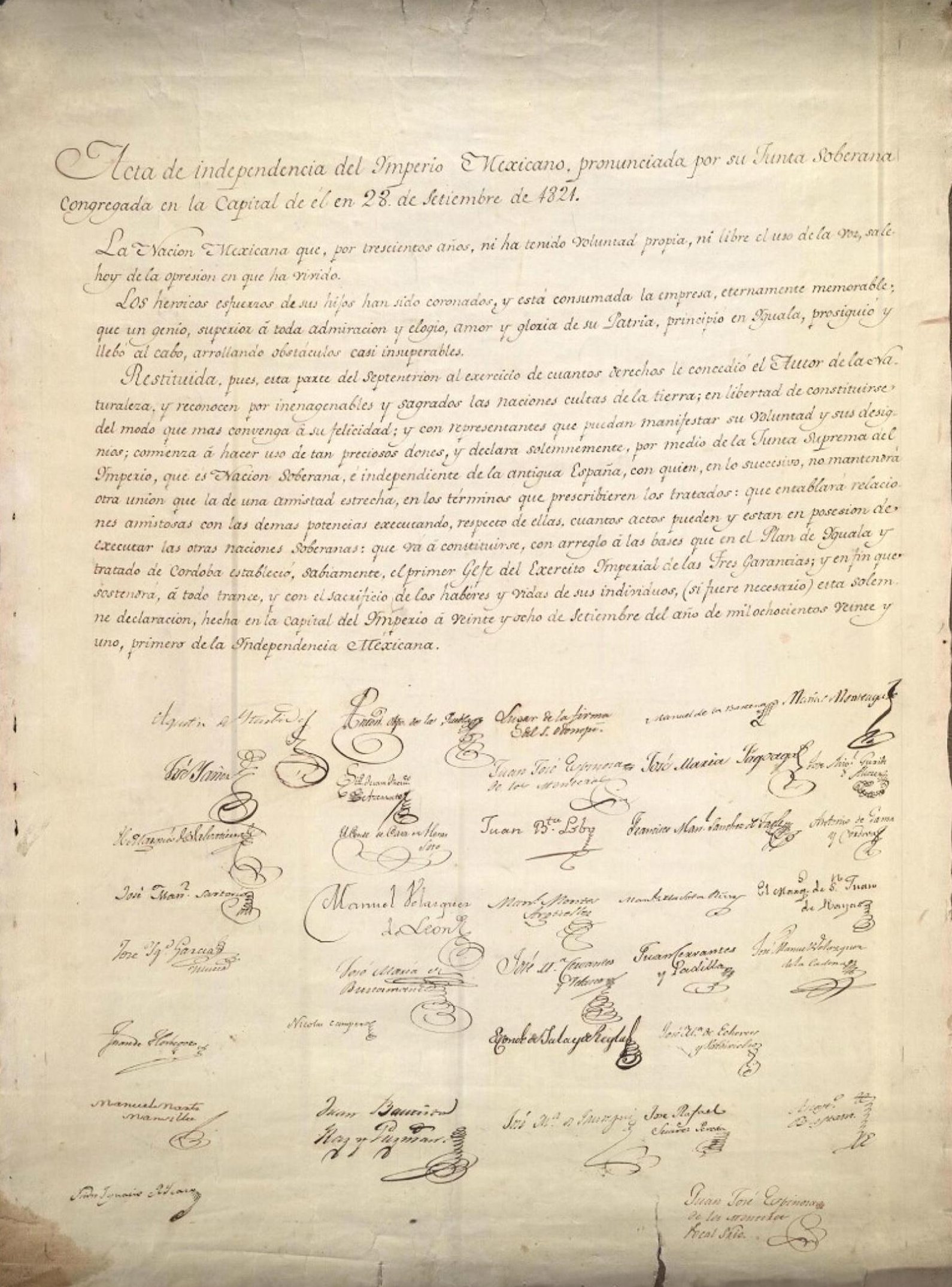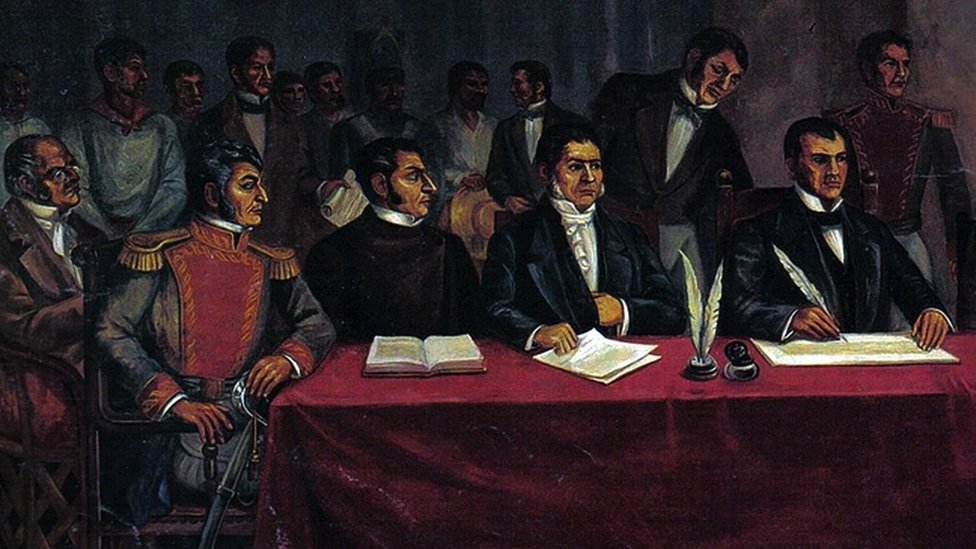The day after the Independence of Mexico was consummated, leaders of the movement signed the country’s birth certificate. But such a moment was not unique in the struggle that began in 1810.
September is the “month of the fatherland” in Mexico, mainly due to the Independence celebrations on the 15th and 16th.
But a date that goes unnoticed is that of the consummation of the battle that gave rise to the birth of Mexico as a country: September 27.
That day in 1821, one of the independence leaders, Agustín de Iturbide, led a symbolic entry march to Mexico City to mark the end of the struggle for independence from the Spanish empire, which lasted exactly 300 years.
The following day, the group led by Iturbide met to proclaim an Act of Independence that, contrary to what happened in other countries in America (with the exception of Haiti), was drawn up after the armed struggle was over.
The act of Mexico “is of an independence that already exists de facto, ” Dr. Alfredo Ávila, from the Institute of Historical Research of the National Autonomous University of Mexico (IIH-UNAM) explains to BBC Mundo.
“The Independence Plan of February 1821 said that first, a ‘governing board’ had to be formed to call a Congress and, the main thing, to declare independence,” the expert abounds.
Said board met before entering Mexico City, with allies of Iturbide and without other insurgent leaders such as Vicente Guerrero. And it had sui generis members because they represented economic sectors rather than territorial ones.

The Act of Independence, which led to the establishment of the Mexican Empire that stretched from northern California to southern Costa Rica, was drafted and signed by members of the governing board.
“The Mexican nation that for 300 years has neither had its own will, nor free use of its voice, is emerging today from the oppression in which it has lived,” he proclaimed.
However, as several scholars of the independence acts of America point out, among them Dr. Ávila, in what is now Mexico there was more than one document of independence from New Spain.
And it is clear that among those who consummated the movement there was no intention of rejecting the Spanish King Fernando VII in Mexican territory, but rather the opposite.
More than one act
The struggle for the independence of Mexico occurred in several stages, with various leaderships and participating groups, between 1810 and 1821.
The feat was undertaken by Miguel Hidalgo y Costilla a Creole priest -son of Spaniards born in America- who participated in a group of conspirators and who gave the famous “Grito de Dolores” that marked the beginning of the fight.
However, Hidalgo was captured and shot in 1811, so other independentistas continued the movement, including the priest José María Morelos y Pavón.

In an effort to formalize the struggle, Morelos called for the creation of the Congress of Anahuac, where in September 1813 a founding document of independent Mexico was read: “Sentimientos de la Nación.”
“It indicates that opulence and destitution must be mitigated. That the country should be free. A series of very important principles and rights. The first article says that independence be declared and its reason exposed to the world,” Avila explains.
Members of Congress promulgated on November 6, 1813, the Solemn Act of the Declaration of Independence of North America, 8 years before the act of 1821.
“It is declared that America was sovereign, because God grants that right to the peoples. That the exercise of sovereignty is recovered, that the Catholic faith will be the only one tolerated and that a Congress will legislate to go to foreign nations to establish relations”, Avila exposes.

The historiography shows that there are two acts of independence. But Ávila affirms that there is one more that is “practically unknown.”
Ignacio López Rayón, one of the leaders of the “realist” wing (in favor of maintaining a link with the Spanish crown) in that Congress, issued a new document with amendments related to his ideology.
“It is declared that the country is fighting to have its own government, but in favor of King Fernando VII of Spain. It is the version that Ignacio López Rayón wanted from the beginning,” Avila indicates.
In addition, a group of independentistas from the northeast of the country had published one more on April 6, 1813, in San Antonio, Texas. So there were at least four documents between 1810 to 1821.
Why several minutes?
The course of the independence struggle ended up favoring the royalists and this was reflected in how the birth of the new nation was conceived, at a time when Spain was also struggling to reestablish the monarchy of Fernando VII.
While Morelos and other insurgent leaders had a sovereignist position of the new country, the fight ended up being led by royalists of the Trigarante Army also called l Spanish king to rule the country again.

For the historian Rodrigo Moreno, from IIH-UNAM, the existence of the acts of 1813 and 1821 is a reflection of this ideological dispute in an “extremely complex” historical process.
“The acts of 1813 and 1821 correspond to different stages and movements. Like any independence declaration, both share the symbolic ambition of creating a sovereign political entity through the word, but they are driven by divergent interests,” he says.
“When the trigarance in 1821 offered the throne of the Mexican Empire to Fernando VII, it sought to reconcile the independence project with fidelity to the monarch : breaking the subordination to the metropolis and the link with the Spanish monarchy, but not subjection to the king,” he adds.

For his part, Ávila points out that the declarations of independence are written so that other countries recognize sovereignty, rather than as a declaration of social or humanistic principles.
“The independence acts are not directed at the people. They are directed to other countries to invite them to establish diplomatic and international relations. This happens from the declaration of Philadelphia (USA) to the most recent ones, such as South Sudan or Crimea. “, Explain.
In the case of Mexico, the royalists in 1821 “want to be ruled by Fernando VII”, but as an independent nation and not a colony of the Spanish crown.
“And if he did not accept, one of the princes. It was a way of maintaining commercial relations, they were very rich people and they wanted to maintain the trade that was very lucrative, ” he adds.

And why isn’t independence celebrated in Mexico on September 28, when the “first day of Mexican Independence” was marked, as the 1821 act says?
“There is a tradition of celebrating the beginnings more than the ends because the endings are usually a transaction, political negotiations that are not very epic,” explains Ávila, who points out that this happened in other countries in America.
“On the other hand, the beginnings are more heroic, of the people who rise up in arms and create legends.”
Source: eleconomista.net





